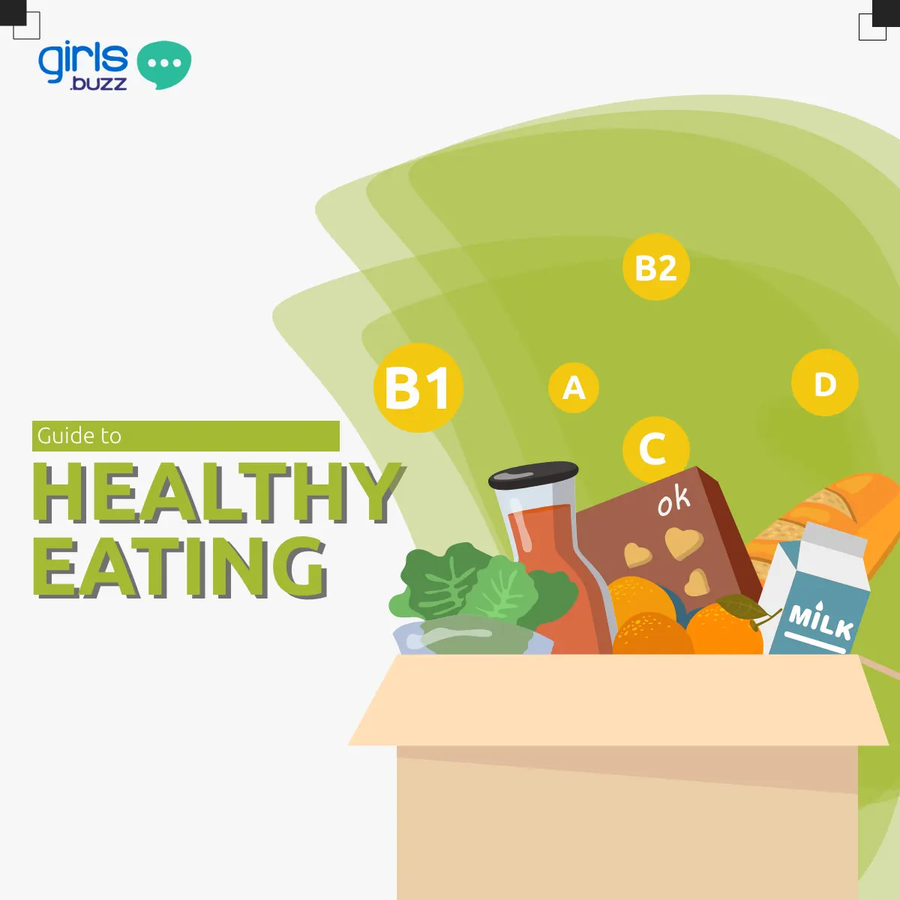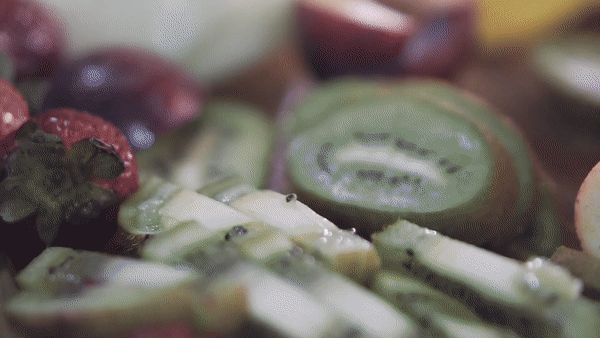Guide To Healthy Eating!
5 minuteRead

What comes to your mind when you hear the words “healthy diet?” Is it a sad-looking person staring at their equally sad-looking salad? Or perhaps it’s an influencer raving about a new smoothie recipe with a concoction of strange ingredients you could swear was straight out of a book of spells and potions.

Despite what social media might have us believe, the key to a healthy lifestyle doesn’t lie in expensive ingredients, gruelling meal restrictions, and hours spent agonizing over the next meal. It’s just about developing good eating habits. And if you’re tired of “cheating” on your diet for the hundredth time, we’ve got some tips to get you to really commit to the life of eating a balanced diet. Here are 6 ways you can make the switch to eating healthy foods.
1.Shop For Your Groceries The Right Way
First things first, before you head to the grocery store, have a comprehensive list of healthy foods to eat every day on hand. That’s where your journey to healthy eating truly begins.
As long as you stick to the list, you can make sure you’ve got the right amount of produce and snacks you need to meet your nutritional requirements. But if you love a lazy dawdle around a grocery store, be sure to do so around the healthy foods section only. Besides this, if you find yourself walking towards the junk food aisles, grab no more than 3 cheat snacks for the week.

2. Eat The Rainbow For Your Micronutrients
When you sit down to eat a meal, be sure to have a plate that’s colourful. And by that we mean to follow your mother’s advice and eat your fruits and vegetables. To get the most nutrition out of your produce, leave the colourful skin on. Phytonutrients in fruits and vegetables, which give them their distinctive colour, have been found to protect heart health and prevent cancer. In fact, they’re at the top of every dietician’s heart-healthy diet charts.
Besides this, fruits and vegetables are excellent sources of most micronutrients, i.e vitamins and minerals. Essential vitamins include vitamins D, C, A, E, K, B1, B2, B6, B12, and folic acid while important minerals include calcium, potassium, sodium, iron, and zinc. Including a variety of produce in your diet is vital to ensure that you not only get these nutrients but also absorb them well.
We recommend going for about 4 cups of colourful fruits and vegetables a day. 1 serving equals ½ cup of chopped veggies and ½ cup of chopped fruits. Aim for 2 servings, 2 times a day and you’re sorted. Snacks count too!
3. Get The Basics Of Macronutrients Down Pat
There’s a whole lot of confusing information out there about what qualifies for healthy eating. However, like with most things in life, it’s important to understand the basics of food and dietary requirements to truly have a handle on what you should be eating every day. To start things off, here’s a look at the fundamental aspects of every meal.
Protein: Perhaps the most talked-about macronutrient in health-food and fitness circles, protein provides sustained energy and supports mood and cognitive function. As we age, it’s imperative to eat a lot of high-quality protein foods to keep our muscles and cognitive functioning in good shape. Contrary to popular notion, you don’t need to load up on steak and eggs to get your protein for the day. A variety of plant-based sources of protein can help you get there too.
Good sources of protein include fatty fish, beans, and nuts.
Carbohydrates: These are one of the body’s main sources of energy. Good sources of carbs are unrefined and complex, such as whole-grain bread, fruits, vegetables, legumes, seeds, nuts, and unpolished whole-grain rice.
Carbohydrates often get a bad rap for supposedly causing weight gain or just not being essential enough, but most nutritionists will agree that cutting them out of your diet will spell trouble in the long term. In the absence of carbs, your body will use up protein and fats for energy. However, in this process, you might miss out on much-needed nutrition and fibre which could lead to health problems down the line.
Fat: Another highly misunderstood macronutrient, fats support cell growth, protect the organs, help the body absorb certain nutrients, and produce important hormones. It’s important to understand that not all kinds of fatty food work the same way. While bad sources of fat can increase the risk of certain diseases, good fats are vital to keep us going.
Sources of healthy fats include chia seeds, avocados, fatty fish like salmon and mackerel, seeds, nuts, and olives.
Fibre: Essential to maintaining healthy bowel movements, having a diet rich in dietary fibre can lower your risk of heart disease, store, and diabetes. As a bonus, it can help amp up the effects of your skincare routine and give your skin a glow. It might even help you lose weight.
Good sources of fibre include oats, seeds, whole-grain bread, fruits, vegetables, and beans.
4. Manage Your Macros, Not Your Calories
The math with calories is simple, if you consume fewer calories than you burn every day, you will lose weight. Inversely, if you consume more calories than you burn, you will store them as new muscle or fat, depending on the source of the said calories. This is why it’s a lot more important for you to watch where your calories are coming from, than how many you’re consuming.
As a rough estimate, 30% of your caloric intake should come from fats, 20% from protein, and 50% from carbohydrates.
5. Keep Healthy Foods In Your Line Of Sight
We’re all well versed in what constitutes healthy and unhealthy foods. But all that awareness goes out the window when we’re hungry and the first thing we see is a bag of chips in our snack drawer. If your healthy food is out of sight, best believe it will also find its way out of your mind. This is why tricking your mind into eating healthy works very well. What you need to do is keep healthy snacks around at an arm’s length. We’re talking apples on the kitchen counter, greek yoghurt on the top shelf in the fridge, or even nuts on your work desk. If the first thing you grab when you reach for a snack is an apple, you’ve succeeded in sticking to your healthy diet. Besides, eating the right kind of foods is also a great way to boost your immune system which is extremely important this pandemic season.
So rearrange everything in your pantry in a way that ensures that all your healthy purchases sit pretty in the front while the bad-for-you chips and soda cans take a backseat.
6. Find Healthier Versions Of Comfort Foods
Okay, we hear you. Sometimes, there’s no suppressing a craving. When you need to have a big bowl of mac and cheese, you just need to have a big bowl of mac and cheese. With soda on the side, of course. To this we say, look up healthy alternatives. The beauty of the internet lies in the fact that you can wish for something traditionally unhealthy to be healthy and someone on the internet is most likely to have found a way to make it come true. An easy way to do this is to swap out unhealthy ingredients with healthier alternatives. Here’s a quick guide for when you’re not feeling up to a Google search.
Replace With
Cream Greek Yoghurt
Sugar Dates
Red meat Fish or legumes
White flour Whole grain flour
White rice Whole grain red, brown, or black rice
Potato Cauliflower
Icecream Frozen Yogurt
Chips Popcorn
Cake Banana bread
If the swaps don’t cut it and you feel the need to dig into the real deal, don’t sweat it. Try eating them less often, instead. This means that if you’re used to eating these foods every single day, dial it back to a few days a week and slowly work your way up to having them once in two weeks.
Besides this, a great way to indulge in comfort foods without compromising on your health is to manage your portion sizes. That means no digging into a tub of ice cream straight up. Pick out a small plate or bowl to eat these foods out of. Maybe grab a smaller spoon so you take smaller bites and slow down the eating process. This way you’ll ensure that you’re not having too much of a bad thing and you’ll have some leftovers to enjoy later!
And there you have it! This guide works really well if you’re just stepping foot in the world of healthy eating. It might seem daunting at first, but once you’ve got your basics down, you’re well on your way to being called a ‘health nut’ in your friend circles. Besides, your mind, body, and immune system will both welcome the change and thank you for it.
Write, Record and Answer! Consume Unlimited Content! All you need to do is sign in and its absolutely free!
Continue with one click!!By signing up, you agree to our Terms and Conditions and Privacy Policy.










